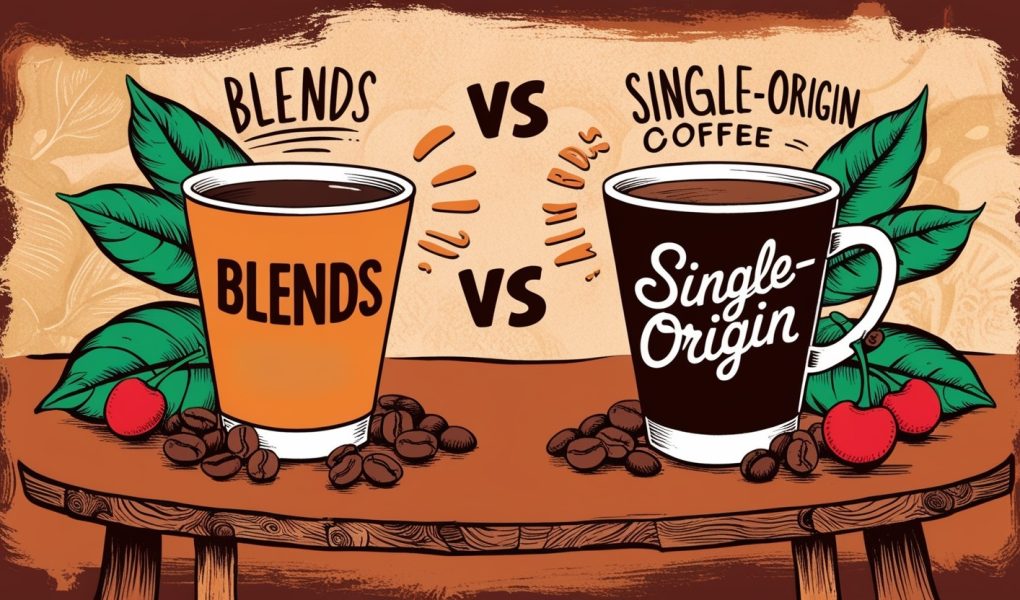Understanding the Coffee Choice
For coffee lovers, the options can feel endless—light roast or dark, pour-over or espresso, hot or iced. But one of the most essential choices comes down to the coffee itself: blend or single-origin? This choice shapes the flavor, aroma, and even the experience of each cup.
Blends offer a familiar, balanced profile that’s crafted by combining beans from different regions, creating a harmony of flavors that’s reliable and smooth. Single-origin coffee, on the other hand, is all about showcasing the unique characteristics of beans from one specific place. Each sip reveals the nuances of its origin, whether it’s a bright, fruity note from Ethiopia or a deep, chocolatey tone from Colombia.
So how do you know which is right for you? Understanding the difference between blends and single-origin coffee can help you decide based on what you love most in a cup of coffee. In this guide, we’ll break down the key traits of each, from flavor to consistency, so you can confidently choose the coffee that suits your taste.
What Is Single-Origin Coffee?
Single-origin coffee is like a snapshot of a specific place, capturing the flavors and qualities unique to that region. Unlike blends, which mix beans from different locations, single-origin coffee comes from one specific area—often a single farm, region, or even country. Each batch tells the story of its origin, with flavors shaped by the soil, climate, and care taken by local farmers.
The appeal of single-origin coffee lies in its purity and character. A cup of single-origin from Ethiopia, for example, might surprise you with bright, fruity notes, while a Colombian coffee could offer a smooth, chocolatey richness. Each origin brings its own distinct personality, and coffee drinkers who love exploring flavors often enjoy how single-origin coffee reveals these natural characteristics.
For those who appreciate variety, single-origin coffee is like a world tour in a cup. With each origin offering something different, single-origin coffees invite you to taste beyond the usual and dive into the unique qualities of each region. While they may vary seasonally and can sometimes be pricier, single-origin coffees are ideal for those who see each cup as an experience worth savoring.
What Is a Coffee Blend?
A coffee blend is crafted with harmony in mind. By combining beans from different regions, farms, or even countries, a blend aims to create a balanced and consistent flavor profile. Unlike single-origin coffee, which celebrates the distinct taste of one specific area, blends are all about bringing together complementary flavors to create a smooth, enjoyable cup every time.
Blending allows coffee roasters to highlight the best qualities of different beans. For example, a roaster might mix the brightness of a Central American coffee with the chocolatey richness of a South American bean, resulting in a cup that’s well-rounded and approachable. This careful balance makes blends a popular choice for everyday drinking and for use in espresso, where a stable, predictable flavor is key.
Another advantage of coffee blends is consistency. While single-origin coffees can vary with each harvest, a blend offers a steady experience, perfect for those who want a reliable cup without surprises. Many coffee shops and brands develop signature blends that reflect their style, giving you a familiar taste you can enjoy again and again.
For coffee drinkers who appreciate a balanced, smooth flavor or simply want a coffee that’s easy to enjoy without overthinking, a blend is a great choice. It’s the art of coffee in its own right, combining the strengths of different beans to create something greater than the sum of its parts.
Flavor Profiles: Blends vs. Single-Origin
The flavor profiles of blends and single-origin coffees offer two very different experiences. Single-origin coffee is like a deep dive into the character of a specific place. Each cup captures the unique qualities of its origin, reflecting the soil, climate, and care taken in growing the beans. With single-origin, you’ll often encounter bold, distinct flavors—like the fruity, floral notes from Ethiopian beans or the smooth, chocolatey richness of Colombian coffee. This clarity and intensity of flavor make single-origin a favorite for those who enjoy exploring unique, sometimes surprising, tastes in their coffee.
Blends, however, are crafted to provide a balanced and consistent experience. By combining beans from various regions, blends smooth out individual characteristics to create a harmonious flavor profile. In a blend, you might notice layers of sweetness, mild acidity, or a rounded, chocolaty depth without any one note standing out too strongly. The goal of a blend is to create a reliable, easy-drinking coffee that appeals to a wide range of tastes, making it a great choice for those who prefer a familiar, comforting cup.
For those who love variety and discovering new flavors, single-origin coffee offers a chance to explore the world through taste, with each cup highlighting the nuances of a different region. Blends, on the other hand, are ideal for coffee drinkers who appreciate a balanced, approachable flavor without too much complexity. Whether you’re drawn to the adventure of single-origin or the reliability of a blend, each style has something special to offer for your daily cup.
Consistency and Availability
When it comes to consistency and availability, blends and single-origin coffees offer two different experiences. Coffee blends are designed for consistency; by combining beans from various regions, roasters can create a flavor profile that stays steady year-round. This makes blends a great choice for those who want a familiar taste in every cup, whether they’re drinking it today or a few months from now. Many coffee shops and brands have their own signature blends that maintain a reliable flavor, so you know exactly what to expect each time.
Single-origin coffee, however, often varies with each season and harvest. Because it comes from a specific region or even a single farm, factors like weather, soil conditions, and growing practices all impact the flavor of the beans. This seasonal nature gives single-origin coffee its unique appeal—each batch brings a slightly different experience, highlighting the distinct qualities of its origin. However, it also means that a favorite single-origin may only be available for part of the year.
For coffee drinkers who enjoy variety and are open to changing flavors, single-origin coffee offers an opportunity to taste the natural shifts that come with each harvest. But if you prefer a coffee you can count on day after day, a blend is more likely to deliver that consistent, comforting flavor.
Both options have their perks, and choosing between them often depends on what you’re looking for in your coffee ritual—whether it’s the reliable taste of a blend or the evolving adventure of single-origin.
Price and Accessibility
When it comes to price and accessibility, blends and single-origin coffees bring different values to the table. Coffee blends are generally more budget-friendly, thanks to the flexibility roasters have in sourcing beans from multiple regions. By blending beans, they can create a high-quality coffee without relying on a single, potentially costly origin. This makes blends more accessible for everyday coffee drinkers who want a good cup without a high price tag.
Single-origin coffee, on the other hand, often comes with a higher price. The focus on specific farms or regions means that single-origin beans are more limited in supply, and the meticulous sourcing adds to their cost. Many single-origin coffees are priced for their uniqueness and exclusivity, appealing to those who see coffee as an experience worth investing in. For those who enjoy exploring the distinct flavors of different regions, the extra cost can feel justified, as each cup offers something special.
In terms of accessibility, blends are typically easier to find in supermarkets, cafes, and online stores, giving you plenty of options no matter where you shop. Single-origin coffees are often more specialized and may require buying from a local roastery or specialty shop, especially if you’re looking for fresh, small-batch roasts.
Whether you’re drawn to the budget-friendly consistency of a blend or the unique experience of single-origin, both options offer something worthwhile. Choosing based on price and accessibility ultimately depends on your priorities—whether it’s a dependable, affordable cup or a taste of something rare and remarkable.
Ideal Scenarios for Each Type
Knowing when to choose a blend or a single-origin coffee can help you get the most out of each cup. Both have their strengths, and picking the right one depends on the occasion, your brewing method, and what you’re in the mood for.
Blends are perfect for everyday coffee moments. If you enjoy a reliable, well-rounded cup to start your day, a blend is a great choice. Blends are also ideal for drinks with milk, like lattes or cappuccinos, because their balanced flavors hold up well against the creaminess without losing their character. Additionally, blends are often more forgiving in terms of brewing methods, making them a solid option whether you’re using a drip machine, French press, or espresso maker. For those who love a classic, smooth coffee with consistent flavor, blends fit the bill.
Single-Origin Coffees shine when you’re looking to savor something unique. These coffees are a wonderful choice for slow coffee moments, like weekend mornings or coffee tastings, where you can appreciate the distinct flavors of a specific region. Single-origin beans often reveal their best qualities in manual brewing methods like pour-over or AeroPress, which highlight subtle notes and allow the bean’s natural character to come through. If you’re in the mood to explore and try new flavors, single-origin coffee can be a delightful adventure.
In short, blends are great for a dependable, everyday cup, while single-origin coffee is the choice for special occasions or when you’re craving a unique experience. Both options bring something valuable to the table, and choosing based on the scenario lets you enjoy the best each type has to offer.
Conclusion: Finding Your Perfect Brew
Choosing between blends and single-origin coffee comes down to your taste preferences, values, and the kind of experience you want in each cup. Blends offer a balanced, reliable flavor that’s perfect for daily enjoyment and pairs well with milk or cream. They’re often more accessible and affordable, making them a go-to choice for a consistent coffee experience.
Single-origin coffees, on the other hand, invite you to explore the unique flavors of specific regions. Each cup tells the story of its origin, bringing a sense of adventure and discovery that’s ideal for those who love variety and want to savor something special.
Both options have their charm. Blends give you a dependable, crowd-pleasing brew, while single-origin coffee lets you appreciate the finer details of coffee’s natural diversity. The beauty of coffee is that you don’t have to choose just one. Enjoy a blend on busy mornings and reach for a single origin when you want a little extra depth. Whichever you prefer, the right coffee is the one that suits your taste and brings you joy.



